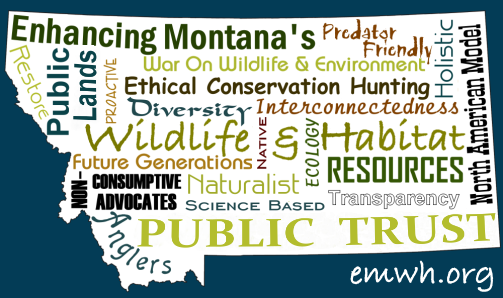Where's The Science?
Change.org
Petition - National Park Service
Request
for National Academy of Sciences
Review of Wildlife Brucellosis in the Greater Yellowstone Area
| The Mission
of the National Academy of Sciences (NAS), a private, non-profit society
of distinguished scholars, is to furthering science in America . Established
by an Act of Congress in 1863, which was signed by President Abraham
Lincoln, the NAS is, "charged with providing independent, objective
advice to the nation on matters related to science and technology."
The NAS scientists are elected by their peers, for outstanding contributions
to research.
"The National Research Council, created under the NAS charter in 1916 by executive order of President Woodrow Wilson, extended the scope of the NAS in its advisory role... The Academy's service to government has become so essential that Congress and the White House have issued legislation and executive orders over the years that reaffirm its unique role." "The National Academy of Sciences charter commits the Academy to provide scientific advice to the government 'whenever called upon' by any government department. The Academy receives no compensation from the government for its services." With this in mind, call upon the National Academy of Sciences to conduct a thorough scientific review of brucellosis disease management, concerning wildlife (predominately elk and bison), in the Greater Yellowstone Area. |
|
Please
Request a National Academy of Sciences Review of To: The issue of brucellosis in the Greater Yellowstone Area States, has severe implications for our livestock industries, as well as our treasured public wild bison and elk. We recognize that our elected officials in Washington D. C., the Greater Yellowstone Area States of Montana, Wyoming and Idaho, in addition to various agencies within the U.S. Departments of Interior and Agriculture, share a need for responsible, peer reviewed science to base their wildlife management decisions on. "The National Academy of Sciences charter commits the Academy to provide scientific advice to the government 'whenever called upon' by any government department." To ensure that science, not politics and special interests, drive the public discussion and foundation of brucellosis disease management policy in the Greater Yellowstone Area wildlife, we are humbly writing to request that you call upon the National Academy of Sciences to conduct a thorough scientific review of brucellosis disease management, concerning wildlife (predominately elk and bison), in the Greater Yellowstone Area. Historically, a number of policies involving brucellosis management have not been rooted in responsible science, rather assumptions. For years, the Federal Animal and Plant Health Inspection Service has been promoting an agenda of brucellosis eradication from the Greater Yellowstone Area, a position which is not socially, humanly, economically and scientifically supported. As a result, by their own statements, millions of federal taxpayer dollars (other sources cite billions) have been spent, targeting Yellowstone National Park bison, on an assumption that the wild bison were the major vector of brucellosis transmission, which actually resides with the elk. Now that the special interest groups and agencies responding to the APHIS brucellosis eradication in wildlife agenda are aware it is the elk genotype, which is a small transmission risk threat to cattle, that machinery is now turning it's sights to the elk populations. Science, not politics, needs to address the following questions: 1. What is the actual zoonotic transmission
risk of Brucella abortus to humans from brucellosis exposed wildlife?(accounting
for the fact that many involved with livestock and wildlife vaccines
are the major source of accidental Brucella abortus infections in
humans) Here is some background prompting this
request: The science being produced today reports that the transmission risk from wild YNP bison to cattle is 0.0-0.3%, elk representing 99.7%-100% of the risk. No documented case of wild bison to cattle transmission has ever occurred in the wild. The genetics show that the Brucella abortus of wild bison differs from that of elk and cattle, which is almost identical, which affects species transmission. "Our results indicate that elk and cattle isolates are virtually identical genetically, differing by only one to two mutational steps. On the contrary, bison B. abortus differed from cattle and elk by 12-20 mutational steps."- DNA Genotyping Suggests that Recent Brucellosis Outbreaks in the Greater Yellowstone Area Originated from Elk, 2009. Molecular Epidemiology of Brucella abortus Isolates from Cattle, Elk, and Bison in the United States, 1998 to 2011, 2012. Of the 99.7%-100% of the risk that elk pose, that risk is 0.00024% chance that any one Montana cattle will become infected from elk. Percentages that can be reduced by recommended mitigation methods such as later cattle turn out dates on public lands, running only spade heifers and steers on public lands, transmission risk methods of stack fencing, etc. Not all cases of brucellosis infections in cattle, since 2008, in the GYA states have been from elk, some have been cattle vaccine blooms and cattle infections. Science, not politics should be managing our wildlife, so I ask you to please request a thorough scientific review by the National Academy of Sciences. Public citizens of the United States, are owed nothing less, in the stewardship, policies and management of our public trust resources, on behalf of this generation and future generations, than the knowledge and ethical principles of peer-reviewed science. Thank you Sincerely, |
Additional Information on Brucellosis in the Greater Yellowstone Area
Your Advertisement Here |
Site designed and maintained by Kathryn QannaYahu




